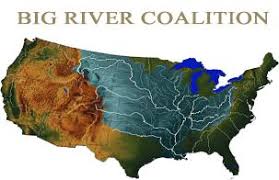The Corps’ Mississippi Valley New Orleans (MVN) began opening bays on the Bonnet Carré Spillway earlier today (Friday, April 3, 2020). The Bonnet Carre´ Spillway is a flood control structure extending from Mile 128.8 Above Head of Passes to Mile 127.3 Above Head of Passes that is designed to pass flood water from the Mississippi River into Lake Pontchartrain to prevent flooding below the Spillway.
The MVN planned to open 20 bays today in order to keep the maximum flow at New Orleans at or below the target flow of 1.25 million cubic feet per second. A rough estimate is that the 20 bays would divert about 18,000 cubic feet per second from the Mississippi River and into Lake Pontchartrain via the floodway.
At 1450 hours on April 2, 2020, Major General Mark Toy, the President of the Mississippi River Commission and Commander of the USACE Mississippi Valley Division (MVD – Vicksburg), granted Colonel Stephen Murphy the District Commander for MVN the authorization to operate the Spillway in accordance with the approved Water Control Manual and MVD Operations Plan for Floods (Memo is attached). Colonel Murphy estimated that 95-110 bays may eventually be opened and that the structure could be operated for a month or so based on efforts to maintain the maximum flow at the structure.
The is the fifteenth time since 1937 that the flood control structure’s operation was required, there are multiple records related to the increase of the structure’s operation – including the first time ever operated in three consecutive years, four times in any three-year period, or 6 times in a ten-year period (2011, 2016, 2018, 2019, 2019, 2020).
The Bonnet Carré Spillway, located 28 miles above New Orleans, is a vital element of the multi-state Mississippi River and Tributaries (MR&T) system, which uses a variety of features to provide flood risk reduction to the alluvial Mississippi Valley from Cape Girardeau, MO to Head of Passes, LA. Located on the east bank in St. Charles Parish, it can divert a portion of the river’s floodwaters via Lake Pontchartrain into the Gulf of Mexico, thus allowing high water to bypass New Orleans and other nearby river communities. The structure has a design capacity of 250,000 cfs, the equivalent of roughly 1,870,000 gallons per second.
BONNET CARRÉ SPILLWAY OPERATION 2020
| DATE | CARROLTON GAUGE (NEW ORLEANS) | NUMBER OF BAYS OPENED | NUMBER OF BAYS CLOSED | NUMBER OF BAYSREMAINING OPEN | SPILLWAY DISCHARGE CUBIC FEET PER SECOND (cfs) |
| 4/3/20 | 16.28 feet | 20* | 0 | 20* | 18,000 cfs* |
*These numbers are based on the plan to open 20 bays today and an estimate by the undersigned, actual numbers will be inserted upon receipt.
A forecast update provided by our colleagues from the National Oceanic and Atmospheric Administration’s (NOAA) Lower Mississippi River Forecast Center is attached, highlights from this update specific to the New Orleans are reproduced below:
“The Bonnet Carré Floodway will be operated today to help reduce flow at New Orleans, LA. This will cause New Orleans, LA and Reserve, LA to crest before upstream locations. New Orleans, LA will be regulated to the 17.0 ft flood stage. This will be the first time that the floodway has been operated for 3 years in a row. The floodway has been operated for 4 of the last 5 years.
The 16 day future rainfall guidance is showing a secondary crest on the lower Ohio River for late April. This crest would be several feel lower than the current crest and it would only slow recessions on the lower Mississippi River for early May.”
The Bonnet Carré Anchorage was closed by the U.S. Coast Guard at 6:00 a.m. this morning (April 3, 2020), vessels shall not enter the anchorage or the area extending 600 feet into the river from the Bonnet Carré Spillway, between MM 127 and MM 129 and the shoreline of Lake Pontchartrain.


